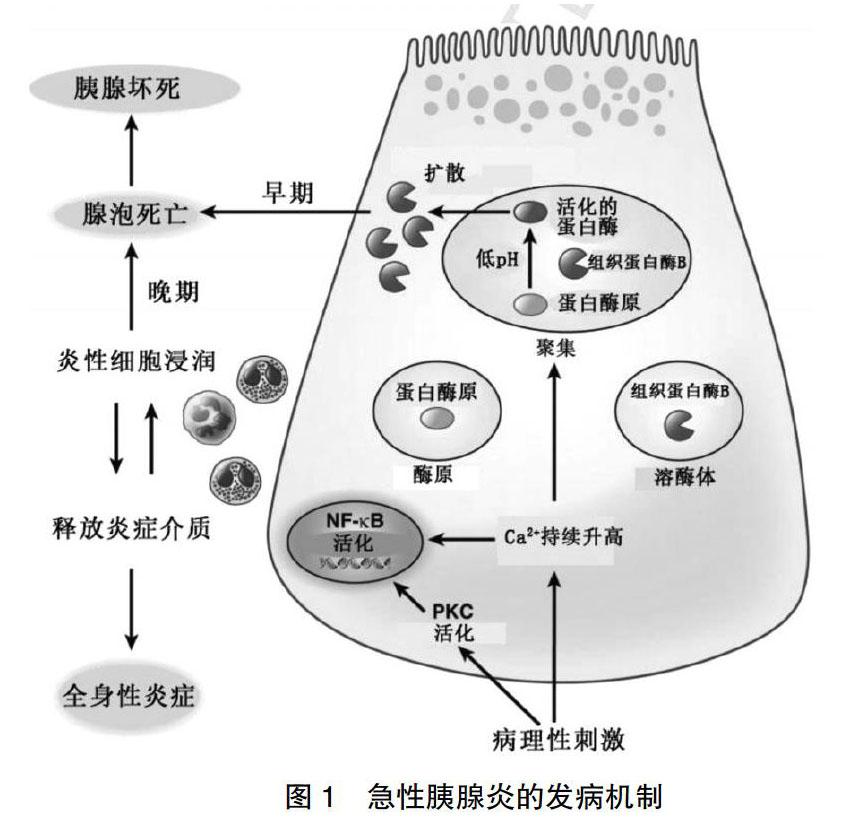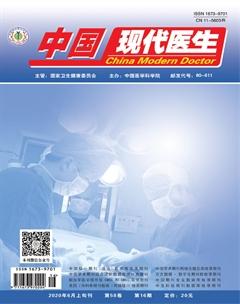长链非编码RNA与胰腺相关疾病的研究进展
丁莺 何洋 杨毅

[摘要] 长链非编码RNA是一种长度大于200个核苷酸的非编码RNA,可在表观遗传、转录以及转录后三个水平调控基因的表达,具有多种生物学功能。胰腺作为人体中最主要、最复杂的器官之一,其生理作用和病理变化均与机体健康息息相关。本文通过搜集大量国内外相关文献,描述并归纳了长链非编码RNA在胰腺疾病,如胰腺炎、胰腺癌、糖尿病中所发挥的作用。本综述旨在提高临床医生对胰腺相关疾病的认知及为其提供新的诊疗方向,并为以后LncRNAs在胰腺疾病中的功能研究奠定基础。
[关键词] 长链非编码RNA;胰腺;胰腺炎;胰腺癌;糖尿病
[中图分类号] R735.9 [文献标识码] A [文章编号] 1673-9701(2020)16-0187-06
Progress of the research on long-chain non-coding RNA and pancreas related diseases
DING Ying1 HE Yang2 YANG Yi3
1.Department of Critical Care Medicine,Xiasha Division,Sir Run Run Shaw Hospital,Zhejiang University School of Medicine,Hangzhou Xiasha Hospital, Hangzhou 310018,China;2.Department of Emergency Medicine,Sir Run Run Shaw Hospital,Zhejiang University School of Medicine,Hangzhou 310016,China;3.Department of Pharmacy,Xiasha Division,Sir Run Run Shaw Hospital,Zhejiang University School of Medicine,Hangzhou Xiasha Hospital,Hangzhou 310018, China
[Abstract] Long-chain non-coding RNA is a non-coding RNA with a length of more than 200 nucleotides. It can regulate gene expression at epigenetic, transcriptional and post-transcriptional levels,and it has a variety of biological functions. Pancreas is one of the most important and complicated organs in human body. Its physiological function and pathological changes are closely related to body health. This paper described and summarized the role of long-chain non-coding RNA in pancreatic diseases such as pancreatitis,pancreatic cancer and diabetes by collecting a large number of relevant domestic and foreign literatures. The purpose of this review is to improve clinicians' understanding of pancreas related diseases and provide a new diagnosis and treatment direction for them,and lay a foundation for future research on the function of LncRNAs in pancreatic diseases.
[Key words] Long-chain non-coding RNA (LncRNAs); Pancreas; Pancreatitis; Pancreatic cancer; Diabetes
在過去很长的一段时间内,RNA只被认为是一座将遗传信息从DNA转移到蛋白质的桥梁,然而,人类基因组测序结果显示,虽然有70%的基因组会转录为RNA,但人类仅有约占全基因组2%的基因(20 000个)编码蛋白质[1]。这个结果促使人们注意到了数量庞大的非编码RNA(non-coding RNA,ncRNA)的存在,但由于其不编码蛋白质,ncRNA曾一度被认为是一种“转录噪音”。近几十年来,随着各种高通量和深度测序技术的发展,ncRNA在调控基因和发育方面的生物功能越来越多的被人类发现[2,3]。长链非编码RNA(Long non-coding RNA,LncRNA)是一种长度大于200个氨基酸的非编码RNA,可参与多种生物过程。越来越多的研究也表明,在胰腺炎、胰腺癌、糖尿病等胰腺相关疾病中,LncRNA的表达出现变化,提示LncRNA可能在其中发挥重要作用[4]。
为了更清楚了解LncRNA与胰腺及胰腺相关疾病之间的关系,为以后LncRNA在胰腺中的功能研究奠定基础,在本文中就LncRNA与胰腺相关疾病的研究进展进行讨论。
1 LncRNA与胰腺的发育
胰腺是人体重要的消化器官及内分泌器官,通过其外分泌腺和内分泌腺两个部分实现功能。随着人们对LncRNA的研究越来越深入,研究人员逐渐发现,LncRNA会参与调控胰腺的发育及胰岛细胞的分化过程。研究者们发现,LncRNA H19可参与糖尿病的子代遗传,并影响糖尿病妊娠母亲胎儿的胰岛结构和功能,这表明LncRNA参与调控胰岛发育和功能的第一个迹象[5]。近几年, Ildem Akerman等[4]做了胰岛转录图谱检测,发现在胰岛中有将近2400个转录本为LncRNA,并有55% 的LncRNA具有高度的胰岛特异性,这些LncRNA可在小鼠胎儿期间动态的调节胰岛发育。
LncRNA除了能推动胰腺的发育过程,还可以影响β细胞的分化与成熟。Dlk1(delta-like 1 homologue)是在胰岛β细胞中高度表达的一种人类印迹基因[6],LncRNA MEG3在其下游转录,研究表明,LncRNA MEG3可通过募集多梳抑制复合物来沉默Dlk1,影响β细胞的识别和功能性成熟[6,7]。胰-十二指肠同源盒1(pancreas-duodenal box 1,Pdx1)是胰岛内分泌细胞转录激活过程中的一种关键性调控分子[8],在NK6相关转录因子1(NK6 transcription factor related 1,NKX6-1)的协同作用下可诱导多能干细胞定向分化为胰岛β细胞[8,9]。有研究表明,多外显子LncRNA XLOC_018755存在于NKX6-1基因的5' N端,其在胰岛β细胞中的表达比非β细胞组织高约1600倍;同时,Pdx1的基因座的反义位置上还结合有一种LncRNA XLOC_019089,这种LncRNA只在胰岛β细胞组织中表达,具有高度特异性。有研究表明,在小鼠中敲除LncRNA βlinc1会引起葡萄糖耐受不良、胰岛素分泌受损,同时减少胰岛β细胞和δ细胞的数量[10],导致大量参与内分泌祖细胞分化和胰岛β细胞成熟、功能调控的基因失调。以上结果均提示LncRNA在胰腺发育与胰岛细胞的分化、成熟等方面可发挥重要作用。
2 LncRNA与胰腺炎
2.1急性胰腺炎概述
急性胰腺炎(Acute pancreatitis,AP)是消化系统中最常见的疾病之一,常见的病因包括胆结石和酒精。其发病机制主要是由于蛋白水解酶在胰腺内的过早激活[11,12]及炎症细胞的侵袭[13](图1)。病理状态下,PKC信号激活且Ca2+离子持续增加,导致NF-κB信号通路的进一步活化,同时组织蛋白酶B能够将胰蛋白酶原提前活化[14,15],导致早期的胰腺腺泡细胞死亡。胰腺腺泡细胞死亡后,大量巨噬细胞浸润到腺泡与酶原共定位的细胞器中并吞噬死亡的腺泡细胞,同时,大量坏死的胰腺腺泡细胞会将巨噬细胞极化为促炎性的M1型巨噬细胞并释放出趋化因子和细胞因子,驱动胰腺出现系统性炎症反应[16,17]。大多数急性胰腺炎患者的炎症反应可随时间慢慢消退,但在约20%的患者中,炎症反应会持续发展,导致全身多种并发症和器官功能障碍,最终造成10%~30%的死亡率[18]。
2.2 LncRNA与胰腺炎
有关于LncRNA在急慢性胰腺炎发展过程中的调控方式的研究较少,直到近几年,人们才慢慢开始关注LncRNA在胰腺炎中的作用。Zhao D等[19]的研究发现,在雨蛙素诱导的急性胰腺炎模型中,LncRNA Fendrr可通过与高表达膜联蛋白A2(Annexin A2,ANXA2)相互作用来促进大鼠胰腺腺泡细胞的凋亡。Baojun LI等[20]的研究发现,LncRNA H19在胰腺炎患者的血清中高表达,且LncRNA H19的表达水平在重症急性胰腺炎患者与轻症急性胰腺炎患者的血清中有显著的统计学差异,未来有望作为临床上诊断急性胰腺炎的潜在生物标志物。Wang L等[21]的研究表明,LncRNA B3GALT5-AS1的过表达可以通过调节miR-203/NFIL3轴及抑制NF-κB激活来减轻大鼠胰腺腺泡细胞AR42J中雨蛙素造模诱导的细胞损伤。虽然这些实验的研究工作还没有进行的很全面,对于LncRNA调控急性胰腺炎发病进程的机制也未深入阐明,但以上实验结果均显示出LncRNA有望作为急性胰腺炎的诊断标志物或治疗靶标。
3 LncRNA与胰腺癌
3.1 胰腺癌概述
胰腺癌(Pancreatic cancer,PC)是世界范围内最为致命的恶性肿瘤之一,在全球总体癌症死亡率持续下降的情况下,胰腺癌的死亡率仍居高不下,且发病率逐年升高。据最新癌症统计数据结果显示,胰腺癌是男性和女性的第三大癌症死亡原因[22,23],每年我国因胰腺癌死亡的人数占全球胰腺癌死亡人数的19.27%[24]。胰腺癌是一种全身性疾病,5年生存率只有5%,即使是接受手術切除的患者,5年生存率也仅有20%[25],并且,发达国家与发展中国家的存活率差异很小[26]。
胰腺癌早期通常没有症状,且在不使用侵入性手术探查的情况下,目前的非侵入性筛查方法不能实现有效的早期诊断;即使诊断出胰腺癌,由于绝大多数患者在初诊时就已经发展为局部晚期和转移性胰腺癌,出现血管和神经的浸润,大部分胰腺癌均不可进行手术切除[24]。据统计,只有约10%的胰腺癌患者能在早期被诊断出来,并成功进行手术切除[22]。
3.2 LncRNA与胰腺癌的早期诊断及预后
根据LncRNA在癌症生物学中所发挥的功能,近年来,越来越多的研究者们认为,LncRNA可以作为潜在的生物标志物用于癌症的早期临床诊断、治疗和预后预测。Wang Y等[27]通过高通量微阵列的方式筛选了胰腺癌患者7500个LncRNA中的胰腺癌潜在生物标志物,发现在胰腺癌患者的肿瘤组织中,LncRNA HOTTIP-005和LncRNA RP11-567G11.1的表达水平显著增加,且两者均具有相对较高的灵敏度和特异性,在胰腺癌的早期阶段即可显示出明显变化,将LncRNA HOTTIP-005和LncRNA RP11-567G11.1作为胰腺癌筛查的血清生物标志物并与CA 19-9的水平相结合,也许可以显著提高胰腺癌的诊断效率。Muller S等[28]通过新一代测序,发现有43个LncRNA在6例胰腺癌患者和5个对照组织中显示出差异表达。同样的,Ye S等[29]使用生物信息学的方法,以高通量测序的数据为基础,发现有21个LncRNA在胰腺癌患者和正常组织中有差异表达。以上结果均表明,LncRNA参与了胰腺癌的发生和发展,并在其中发挥重要作用,具有潜在的诊断价值。
侵袭和迁移是恶性肿瘤重要的生物学特征,在胰腺癌中,神经侵袭是一种攻击行为,会影响胰腺癌手术的切除效果及预后[30]。已有研究者发现,与非肿瘤组织相比,LncRNA HOTAIR在胰腺肿瘤中高表达,且可影响肿瘤细胞的侵袭能力、调节细胞活力和细胞周期进程,可作为胰腺癌患者的预后因子[31]。同时,Peng W等[32]通过检测304例胰腺癌患者肿瘤组织及正常组织中LncRNA HULC的表达后发现,高表达的LncRNA HULC与晚期淋巴结转移、血管侵犯和肿瘤大小有着显著相关性。接着他们又评估了LncRNA HULC的表达与胰腺癌患者预后之间的关系,Kaplan-Meier分析显示,LncRNA HULC的表达水平高的患者生存时间明显短于LncRNA HULC低表达的患者,多变量分析也进一步揭示LncRNA HULC表达是胰腺癌患者存活率差的重要独立预测因子。Ye S等[29]选择肌动蛋白丝相关蛋白1反义RNA(AFAP1-AS1)作为预后标志物测量了胰腺癌患者的LncRNA表达谱,发现其与淋巴结转移、神经周围浸润和生存率低有关。并且,当LncRNA AFAP1-AS1作为胰腺癌的预后标志物时,受试者ROC曲线下面积可达到0.8669。
4 LncRNA与胰腺神经内分泌瘤
胰腺神经内分泌瘤(Pancreatic neuroendocrine tumor,PENT)是一种较为罕见的胰腺肿瘤,在所有原发性胰腺恶性肿瘤中占比不足5%,每年的发病率不足十万分之一。胰腺神经内分泌瘤可分为两类:一种为与激素分泌相关且表现出临床症状的功能性胰腺神经内分泌瘤,包括胰高血糖素瘤、胰岛素瘤、生长抑素瘤等;另一种为无功能性胰腺神经内分泌瘤,虽然激素过量产生但并未出现功能性病变。胰高血糖素瘤多表现为体重降低、糖尿病并伴随有特异性皮炎和口炎等黏膜异常,诊断方法为检测胰高血糖素水平;胰岛素瘤的临床表现为神经低血糖症和出汗、心悸等症状,诊断的金标准为3 d饥饿试验;生长抑素瘤通常表现为糖尿病、脂肪泻以及一些胆囊疾病,沙洋瘤小体是其典型的病理表现,临床上可通过检测血浆中的生长抑素类似物来诊断。一旦确诊,手术切除是胰腺神经内分泌瘤的唯一治疗手段,而对于一些不可切除的晚期胰腺神经内分泌瘤,则针对激素受体采用药物靶向治疗。
神经内分泌瘤的最常见位置是在肠道、胰腺和肺,关于非编码RNA和神经内分泌恶性肿瘤的相关研究较少。来自Roldo等的一项研究数据显示,miRNA在胰腺肿瘤中的表达模式与在正常胰腺组织中不同,以此能将胰腺肿瘤与正常胰腺组织区分开,表明一些miRNA可能参与胰腺肿瘤的发生。如,miR-103和miR-107的高表达以及miR-155的低表达能够在胰腺肿瘤中检测出来。miR-204主要在胰岛素瘤中表达,并与胰岛素的免疫组织化学水平相关,而miR-21的过表达与高Ki67增殖指数和肝转移的存在密切相关。
由于胰腺神经内分泌瘤的发病率较低,LncRNA在胰腺神经内分泌瘤中的研究较少。Iyer S等[33]发现LncRNA MEG3在胰腺神经内分泌瘤中显著下调,在小鼠胰岛素瘤细胞中敲低LncRNA MEG3会使致癌肝细胞生长因子(Hepatocyte growth factor,HGF)受体c-MET异常升高,过表达LncRNA MEG3则会使c-MET下调,损害细胞侵袭和迁移能力。c-MET可促进伤口修复、组织再生和癌症转移,其上调常与肿瘤的不良预后有关[34]。以上结果表明LncRNA MEG3在胰腺神经内分泌瘤中具有抗肿瘤活性。
5 LncRNA与糖尿病
5.1 LncRNA与1型糖尿病
1型糖尿病(Type 1 diabetes mellitus,T1DM)是一种慢性自身免疫性疾病,仅占糖尿病患者的5%~10%[35]。在T1DM中,胰岛β细胞自身免疫破坏,引起胰岛素缺乏,最终导致高糖血症。T1DM患者终身都需要依赖外来胰岛素以维持血糖平稳。近年来,T1DM一直被认为由环境风险因素和遗传易感性导致,T1DM与6号染色体上主要组织相容性复合体(Major histocompatibility complex,MHC)中的人类白细胞抗原(Human leukocyte antigen,HLA)关联紧密,并且HLA单倍型会严重影响自身免疫的遗传易感性,所以HLA是T1DM风险的主要遗传决定因素[36]。
已经有多项研究表明LncRNA在T1DM中可发挥潜在作用。LncRNA TUG1是哺乳动物中高度保守的LncRNA,在小鼠胰腺组织中高表达。在小鼠β细胞中,高血糖可导致LncRNA TUG1的下调,促进细胞凋亡并减少胰岛素的合成和分泌[37]。这些发现表明LncRNA TUG1的下调会损害β细胞的功能,提示LncRNA TUG1可能与糖尿病發病机制有关。LncRNA MEG3是位于人类14号染色体上的LncRNA,与视网膜发育、神经发生密切相关[38],在人β细胞中也高表达[39]。小鼠胰岛β细胞株Min6细胞中敲低LncRNA MEG3可影响β细胞凋亡并减少胰岛素合成,小鼠的体内实验中也显示出同样的趋势[40]。同时,You LH等[41]的研究发现,DLK1-MEG3基因区域可改变对T1DM的易感性。
T1DM是一类由β细胞自身破坏的自身免疫性疾病,近年来,越来越多的证据表明LncRNA的表达失调与一系列自身免疫性疾病密切相关。Hrdlickova B等[42]对9种类型的自身免疫性相关疾病的基因芯片进行检测,发现自身免疫性疾病相关基因座中的LncRNA在免疫细胞亚群中富集。LI Z等[43]的研究发现,许多LncRNA能够调节巨噬细胞的活化,其中,LncRNA Linc1992是维持许多先天免疫相关基因表达所必需的,其可以与不均一核糖蛋白L(heterogeneous nuclear ribonucleoprotein,hnRNPL)结合,通过两者的相互作用调节TNF-α的表达。同时,LncRNA也被证明在Toll样受体(toll-likereceptor,TLR)信号通路中发挥着关键作用[44]。如LncRNA Cox2A在用TLR配体刺激巨噬细胞和树突细胞时可被高度诱导,并且hnRNP-A/B和A2/B1可以与LncRNA Cox2A结合,控制干扰素刺激基因(Interferon stimulated genes,ISGs)和促炎细胞因子的基础表达水平。由以上研究结果可以看出,LncRNA在自身免疫疾病中发挥着重要的作用,在以后的研究工作中,或许可以从这个角度出发,更为全面深入的研究LncRNA在T1DM发病过程中的作用。
[5] Motterle A,Sanchez-Parra C,Regazzi R. Role of long non-coding RNAs in the determination of beta-cell identity[J]. Diabetes,Obesity and Metabolism,2016,18:41-50.
[6] Falix FA,Dani?l C Aronson,Lamers WH,et al. Possible roles of DLK1 in the Notch pathway during development and disease[J]. Biochimica et Biophysica Acta,2012,1822(6):988-995.
[7] Kameswaran V,Bramswig N,Mckenna L,et al. Epigenetic regulation of the DLK1-MEG3 microRNA cluster in human type 2 diabetic islets[J]. Cell Metabolism,2014, 19(1):135-145.
[8] Johnson JD,Ahmed NT,Luciani DS,et al. Increased islet apoptosis in Pdx1+/- mice[J]. Journal of Clinical Investigation,2003,111(8):1147-1160.
[9] Walczak MP,Drozd AM,Stoczynska-Fidelus E,et al. Directed differentiation of human iPSC into insulin producing cells is improved by induced expression of PDX1 and NKX6.1 factors in IPC progenitors[J]. Journal of Translational Medicine,2016,14(1):341.
[10] Arnes L,Akerman I,Balderes DA,et al. βlinc1 encodes a long noncoding RNA that regulates islet β-cell formation and function[J]. Genes & Development,2016,30(5):502-507.
[11] Whitcomb DC,Gorry MC,Preston RA,et al. Hereditary pancreatitis is caused by a mutation in the cationic trypsinogen gene[J]. Nat Genet,1996,14(2):141-145.
[12] Hofbauer B,Saluja AK,Lerch MM,et al. Intra-acinar cell activation of trypsinogen during caerulein-induced pancreatitis in rats[J]. The American Journal of Physiology,1998,275:G352-G362.
[13] Sabrina Gea-Sorlí,Closa D. Role of macrophages in the progression of acute pancreatitis[J]. World Journal of Gastrointestinal Pharmacology and Therapeutics,2010,1(5):107-111.
[14] Halangk W,Lerch MM,Brandt-Nedelev B,et al. Role of cathepsin B in intracellular trypsinogen activation and the onset of acute pancreatitis[J]. Journal of Clinical Investigation,2000,106(6):773-781.
[15] Lerch M,Gorelick F. Early trypsinogen activation in acute pancreatitis[J]. Medical Clinics of North America,2000, 84(3):549-563.
[16] Lawrence T,Willoughby DA, Gilroy DW. Anti-inflammatory lipid mediators and insights into the resolution of inflammation[J]. Nature Reviews Immunology,2002,2(10):787-795.
[17] Cocco RE,Ucker DS. Distinct modes of macrophage recognition for apoptotic and necrotic cells are not specified exclusively by phosphatidylserine exposure[J]. Molecular Biology of the Cell,2001,12(4):919-930.
[18] Madhav Bhatia,Mark Brady,Sheila Shokuhi,et al. Inflammatory mediators in acute pancreatitis[J]. The Journal of Pathology,2000,190(2):117-125.
[19] Zhao D,Ge H,Ma B,et al. The interaction between ANXA2 and lncRNA Fendrr promotes cell apoptosis in caerulein-induced acute pancreatitis[J]. Journal of Cellular Biochemistry,2019,120(5):8160-8168.
[20] Baojun LI,Lai H,Yuanxin S,et al. Expression of long non-coding RNA H19 in serum in patients with acute pancreatitis and its clinical significance[J]. Journal of Clinical Hepatology,2017,3(3):492-496.
[21] Wang L,Zhao X,Wang Y. The pivotal role and mechanism of long non-coding RNA B3GALT5-AS1 in the diagnosis of acute pancreatitis[J]. Artificial Cells,Nano-medicine and Biotechnology,2019,47:2307-2315.
[22] Siegel RL,Miller KD,Jemal A. Cancer statistics,2018[J]. CA:A cancer journal for clinicians,2018,68(1):7-30.
[23] Zhu H,Li T,Du Y,et al. Pancreatic cancer:Challenges and opportunities[J]. BMC Medicine,2018,16(1):214.
[24] Lin QJ,Yang F,Jin C,et al. Current status and progress of pancreatic cancer in China[J]. World Journal of Gastroenterology,2015,(21):7988-8003.
[25] Conroy T,Bachet JB,Ayav A,et al. Current standards and new innovative approaches for treatment of pancreatic cancer[J]. European Journal of Cancer,2016,57:10-22.
[26] Sant M,Aareleid T,Berrino F,et al. EUROCARE-3: Survival of cancer patients diagnosed 1990-94--results and commentary[J]. Annals of Oncology,2003,14(Supple 5):v61-118.
[27] Wang Y,Li Z,Zheng S,et al. Expression profile of long non-coding RNAs in pancreatic cancer and their clinical significance as biomarkers[J]. Oncotarget,2015,6(34):35684-35698.
[28] Muller S,Raulefs S,Bruns P,et al. Erratum to: Next-generation sequencing reveals novel differentially regulated mRNAs,lncRNAs,miRNAs,sdRNAs and a piRNA in pancreatic cancer[J]. Molecular Cancer,2015,14:94.
[29] Ye S,Yang L,Zhao X,et al. Bioinformatics method to predict two regulation mechanism:TF-miRNA-mRNA and lncRNA-miRNA-mRNA in pancreatic cancer[J]. Cell Biochemistry and Biophysics,2014,70(3):1849-1858.
[30] Bapat AA,Hostetter G,Von Hoff DD,et al. Perineural invasion and associated pain in pancreatic cancer[J]. Nature Reviews Cancer,2011,11(10):695-707.
[31] Kim K,Jutooru I,Chadalapaka G,et al. HOTAIR is a negative prognostic factor and exhibits pro-oncogenic activity in pancreatic cancer[J]. Oncogene,2013,32:1616-1625.
[32] Peng W,Gao W,Feng J. Long noncoding RNA HULC is a novel biomarker of poor prognosis in patients with pancreatic cancer[J]. Medical Oncology,2014,31(12):346.
[33] Iyer S,Modali SD,Agarwal SK. The long non-coding RNA MEG3 is an epigenetic determinant of oncogenic signaling in functional pancreatic neuroendocrine tumor cells[J]. Molecular and Cellular Biology,2017,37(22):e00278-17.
[34] Trusolino L,Bertotti A,Comoglio PM. MET signalling:Principles and functions in development,organ regeneration and cancer[J]. Nature Reviews. Molecular Cell Biology,2010,11(12):834-848.
[35] Home C. Self-reported visual impairment among persons with diagnosed diabetes-United States,1997-2010[J]. Morbidity & Mortality Weekly Report,2011,60(45):1549-1553.
[36] American Diabetes Association. Diagnosis and classification of diabetes mellitus[J]. Diabetes Care,2010,33(Suppl 1):S62-S69.
[37] Liu X,Hong C,Wu S,et al. Downregulation of lncRNA TUG1 contributes to the development of sepsis-associated acute kidney injury via regulating miR-142-3p/sirtuin 1 axis and modulating NF-κB pathway[J]. Journal of Cellular Biochemistry,2019,120(7):11331-11341.
[38] Miyoshi N,Wagatsuma H,Wakana S,et al. Identification of an imprinted gene,Meg3/Gtl2 and its human homologue MEG3,first mapped on mouse distal chromosome 12 and human chromosome 14q[J]. Genes to Cells,2000, 5(3):211-220.
[39] Blackshaw S,Harpavat S,Trimarchi J,et al. Genomic analysis of mouse retinal development[J]. Plos Biology,2004,2(9):E247.
[40] Dorrell C,Schug J,Lin CF,et al. Transcriptomes of the major human pancreatic cell types[J]. Diabetologia,2011, 54(11):2832-2844.
[41] You LH,Wang N,Yin DD,et al. Downregulation of long noncoding RNA Meg3 affects insulin synthesis and secretion in mouse pancreatic beta cells[J]. Journal of Cellular Physiology,2016,231(4):852-862.
[42] Hrdlickova B,Kumar V,Kanduri K,et al. Expression profiles of long non-coding RNAs located in autoimmune disease-associated regions reveal immune cell-type specificity[J]. Genome Medicine,2014,6(10):88.
[43] Li Z,Chao TC,Chang KY,et al. The long noncoding RNA THRIL regulates TNFαexpression through its interaction with hnRNPL[J]. Proceedings of the National Academy of Sciences,2014,111(3):1002-1007.
[44] Wallace C,Smyth DJ,Maisuria-Armer M,et al. The imprinted DLK1-MEG3 gene region on chromosome 14q32.2 alters susceptibility to type 1 diabetes[J]. Nature Genetics,2009,42(1):68-71.
[45] Carpenter S,Aiello D,Atianand MK, et al. A long noncoding RNA mediates both activation and repression of immune response genes[J]. Science,2013,341(6147):789-792.
[46] Bell GI,Polonsky KS. Diabetes mellitus and genetically programmed defects in beta-cell function[J]. Nature,2001,414(6865):788-791.
[47] Aguiree F, Brown A, Cho NH, et al. IDF Diabetes Atlas: Sixth edition[M]. International Diabetes Federation,2013:1-155.
[48] Motterle A,Gattesco S,Peyot ML,et al. Identification of islet-enriched long non-coding RNAs contributing to β-cell failure in type 2 diabetes[J]. Molecular Metabolism,2017,6(11):1407-1418.
[49] Donath MY,Schumann DM, Faulenbach M,et al. Islet inflammation in type 2 diabetes:From metabolic stress to therapy [J]. Diabetes Care,2008,31(Suppl 2):S161-S164.
[50] Donath MY,Boni-Schnetzler M,Ellingsgaard H,et al. Islet inflammation impairs the pancreatic beta-cell in type 2 diabetes[J]. Physiology,2009,24(6):325-331.
[51] Elmarakby AA,Sullivan JC. Relationship between oxidative stress and inflammatory cytokines in diabetic nephropathy[J]. Cardiovascular Therapeutics,2012,30(1):49-59.
[52] Sun Y,Peng R,Peng H,et al. miR-451 suppresses the NF-kappaB-mediated proinflammatory molecules expression through inhibiting LMP7 in diabetic nephropathy[J]. Molecular and Cellular Endocrinology,2016,433:75-86.
[53] Carter G,Miladinovic B,Patel AA,et al. Circulating long noncoding RNA GAS5 levels are correlated to prevalence of type 2 diabetes mellitus[J]. BBA Clinical,2015,4:102-107.
[54] Yi H,Peng R,Zhang LY,et al. LincRNA-Gm4419 knockdown ameliorates NF-κB/NLRP3 inflammasome-mediated inflammation in diabetic nephropathy[J]. Cell Death and Disease, 2017,8(2):e2583.
[55] Matsuda M,Defronzo RA. Insulin sensitivity indices obtained from oral glucose tolerance testing:Comparison with the euglycemic insulin clamp[J]. Diabetes Care,1999, 22(9):1462-1470.
[56] Amaral PP,Clark MB,Gascoigne DK,et al. lncRNAdb:A reference database for long noncoding RNAs[J]. Nucleic Acids Research,2011,39:D146-151.
[57] Li X,Zhao Z,Gao C,et al. The diagnostic value of whole blood lncRNA ENST00000550337.1 for pre-Diabetes and type 2 diabetes mellitus[J]. Experimental and Clinical Endocrinology & Diabetes,2017,125(6):377-383.
(收稿日期:2019-11-25)

